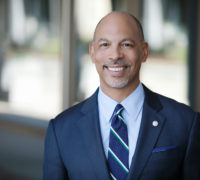
“We were so scared of our IPO”: Leaders Unplugged with former On-CEO Marc Maurer
Marc Maurer shares how ON grew from startup to IPO by defying hype, focusing on purpose, and leading with humility in this candid Leaders Unplugged episode....

by Michael D. Watkins, Eugene A. Woods Published January 20, 2022 in Leadership • 9 min read
Many organizational leaders ascend to the top job because they have proved their mettle in building and leading teams, driving execution and crafting vision and strategy. They often have less experience in managing the media, engaging in industry forums, interacting with governments and working with other key stakeholders.
Yet as the pressure grows on CEOs to speak out on topics ranging from climate change to mental health and diversity and equity, leaders would be foolhardy to neglect this side of the job. Just as diplomats seek to advance the interests of their nations, you need to engage with a wide range of powerful external players to advance the interests of your organization and create value for all parties.
It may be tempting for operationally orientated, first-time CEOs to focus on what got them the top job – running the business. This is especially the case if they inherit significant operational issues that consume their time in the early months and then fail to pivot and spend more time externally once internal matters are under control. The dangers of underinvesting in external engagement can rapidly come home to roost – e.g., if the organization faces a product or quality crisis and the CEO hasn’t built trust with the media and government officials. An executive who has cultivated authentic relationships with the communities outside his or her office will begin to build emotional capital that can buy the time and purchase the patience that is needed to dampen doubts and quell criticism when the organization is in the line of fire. In moments of crisis, time is often the ingredient that can make the difference in a CEO’s success or failure.
Equally some CEOs get swept up in the attention and fall into the trap of spending too much time courting the media and external stakeholders to the detriment of day-to-day operations. Of course, having a CEO with a strong public profile can be an asset for a company, helping to attract new clients, top talent and open the door for acquisitions. And, while it may be flattering to be invited to speak at conferences and thought-provoking forums, it is important to be targeted with your time, ensuring you focus on activities that truly add value to the organization. At the same time, don’t underestimate the power of the CEO’s voice internally. Ultimately there is no substitute for CEOs when it comes to articulating vision and strategy to their organization or communicating the rationale for change.
The CEO role is ultimately a balancing act between managing the increased external demands and internal priorities. To help you make the right decisions on how to allocate your time and energy, it helps to have a robust and solid foundation to orient you to the external work in the right ways. Here are seven basic principles, starting with adopting the right mindset.

This may seem obvious, but the right framing can help clarify what you should and should not be doing. With all things being equal, you should allocate your time externally to the activities that best advance your organization’s mission and strategy (and also, of course, to dealing with crises and emergent external threats that could damage your organization). The activities that generate the most value vary from organization to organization; they should be aligned with the organization’s overall competitive strategy and informed by an analysis of its strengths, weaknesses, opportunities and threats. Your primary focus could be on:
Often, it’s a combination of several of these and the mix may shift over time. Regardless, the key is to relentlessly focus on what truly creates value for your organization, and to let go of the rest.
While CEOs have substantial authority to make things happen internally, external interactions are all about exerting influence. You need to build relationships but, more importantly, you need to gather intelligence, negotiate with key stakeholders and create alliances on behalf of your organization. In doing so, it helps to think about your efforts as the business equivalent of international diplomacy. One former CEO, who became a U.S. ambassador after he retired, put it this way: “It requires a great deal of diplomacy to run a company. Your employees, your shareholders, and most importantly your customers are all constituencies. You have to be a diplomat in the sense of listening to people, understanding what people want, and finding a way to deliver it.” With a growing emphasis on environmental, social and governance (ESG) issues, companies must consider the impact of their entire supply chain and how to engage with the communities in which they operate to create value for all parties. We call this “managing from the middle of the road” because business and life work best if the environment is a positive one and not “us vs. them.” Similarly, effective business diplomats are skilled in connecting, tracking developments, negotiating agreements and building coalitions. They reflexively think politically, in terms of understanding interests, agendas and alignments. Critically, they create supportive alliances before they need them, building trust and credibility that can be an essential resource in times of crisis.

“It requires a great deal of diplomacy to run a company. Your employees, your shareholders, and most importantly your customers are all constituencies. You have to be a diplomat in the sense of listening to people, understanding what people want, and finding a way to deliver it.”- Former CEO who became a U.S. ambassador
As a new CEO, you have an executive team to help you run the business. However, you need another team to support you in shaping the external environment, a group of people who focus substantial time on developing and executing a stakeholder engagement strategy. Your external relations team typically will include functions such as government relations, legal, public/corporate affairs and communications, and may include fully dedicated personnel such as schedulers and speechwriters. Critically, you need someone whose job it is to work with you to orchestrate this work. This could be your Chief of Staff, which is an increasingly critical role in helping CEOs to establish and pursue priorities, and balance internal and external responsibilities.
The time you spend focusing on external work will, of course, ebb and flow in response to emerging threats and opportunities. But it’s important to set a rough “time budget” for how you will allocate your time between leading internally and influencing externally. Otherwise, it’s all too easy for priorities and values to drift out of balance. Having established a budget, your team needs to help you monitor how you actually spend your time and strive to stay within it. If you find this process too challenging on an ongoing basis, then either you need to change the budget (which may mean pulling back on how you lead internally to free up more time) or cutting back on what you are doing externally. Also, allocating your time well is not just about the amount of time you spend; it’s also about establishing a rhythm so that you don’t end up with a fragmented schedule. For example, you could decide to allocate Tuesday through Thursday of every second week to external activity. Is it always possible to maintain this sort of discipline? No. But as CEO, you have significant control over how you spend your time, even externally.
Having established the team, you need a disciplined process – and one that largely doesn’t involve you – to establish priorities, process the many potential external activities in which you could engage, and allocate your time. The prioritization, as discussed previously, should flow from an assessment of what activities will add the greatest value, given the amount of time you have budgeted for this work. It’s all about making (and critically having others help you make) the right trade-offs. Michael Porter famously said that “the essence of strategy is deciding what not to do.” That’s true, but the essence of execution is actually not doing what you decide not to do and this takes discipline. What you need is a “funnel” into which flows the wide range of offers and opportunities you will have and out of which comes the focused, coherent, value-added set of activities in which you will engage. It’s your job to build the team that runs the funnel, and to provide them with the prioritization criteria that governs its workings. It’s their job (with some oversight by you) to make the prioritization and scheduling process run like a proven algorithm.
You shouldn’t be the only executive shaping the external environment for your organization. In addition to your support team, other members of the executive team (e.g., your General Counsel for government regulation, head of business development for potential acquisitions, CHRO for employment branding or CMO for key customer relationships) should help develop the external engagement strategy, leverage their networks to support it and have clear roles and responsibilities in its execution. You also could engage leaders at lower levels in the organization, especially facility-level leadership, to exert influence in their respective communities. In hospital systems, for example, each hospital is a substantial employer and customer embedded in a specific community. The leader of each hospital, therefore, has the potential to be an influential figure in that community. Thus, leaders at many levels can play valuable roles in helping to shape the external environment in which your company can thrive.
Finally, it’s a tremendous help if everyone – including the involved executives and the external relations support team – uses the same concepts, terms and tools to guide this work. Identifying and understanding key stakeholders, for example, is an essential foundation for effectively in shaping the external environment. There are good, simple-to-use tools available for mapping stakeholders and understanding networks of influence. Likewise, there is a lexicon of common influence strategies, such as the use of sequencing (deciding the right order in which to have conversations with key stakeholders) to build alliances. It also makes sense to have a system for issue tracking and management. While it is important to have the right tools, the key is to have everyone, to the greatest extent possible, using the same ones. So, you should bring your support team to the table to evaluate which will be the best to use.
We are mindful that there are no guarantees in good governance. In healthcare, especially, we have learned over the years that what works in, say, Des Moines or Tacoma may produce different results in Trenton or Tampa. But by adopting this set of seven organizing principles, you will find it much easier to manage your time and be effective in shaping the external environment. In doing so, you and others on your team will be better able to make a lasting difference in your community and your organization. After all, isn’t that what effective leadership is all about?

Professor of Leadership and Organizational Change at IMD
Michael D Watkins is Professor of Leadership and Organizational Change at IMD, and author of The First 90 Days, Master Your Next Move, Predictable Surprises, and 12 other books on leadership and negotiation. His book, The Six Disciplines of Strategic Thinking, explores how executives can learn to think strategically and lead their organizations into the future. A Thinkers 50-ranked management influencer and recognized expert in his field, his work features in HBR Guides and HBR’s 10 Must Reads on leadership, teams, strategic initiatives, and new managers. Over the past 20 years, he has used his First 90 Days® methodology to help leaders make successful transitions, both in his teaching at IMD, INSEAD, and Harvard Business School, where he gained his PhD in decision sciences, as well as through his private consultancy practice Genesis Advisers. At IMD, he directs the First 90 Days open program for leaders taking on challenging new roles and co-directs the Transition to Business Leadership (TBL) executive program for future enterprise leaders, as well as the Program for Executive Development.

President and Chief Executive Officer of Atrium Health
Eugene A Woods is President and CEO of Atrium Health, one of the largest non-profit and leading academic health systems in the United States, with over 70,000 employees serving patients at 40 hospitals and more than 1,400 care locations across five states. He has more than 30 years of healthcare leadership experience. He holds a bachelor’s degree in health planning and administration, a master’s degree in business administration, and a master’s degree in health administration from Pennsylvania State University.

July 8, 2025 • by Alyson Meister, Marc Maurer in Leadership
Marc Maurer shares how ON grew from startup to IPO by defying hype, focusing on purpose, and leading with humility in this candid Leaders Unplugged episode....

July 7, 2025 • by Richard Baldwin in Leadership
The mid-year economic outlook: How to read the first two quarters of Trump...

July 4, 2025 • by Arturo Pasquel in Leadership
Susanne Hundsbæk-Pedersen, Global Head of Pharma Technical Operations at Roche, shares how she has navigated the various pivots in her career, and the importance of curiosity, optimism and energy. ...

July 3, 2025 • by Eric Quintane in Leadership
Entrepreneurial talent who work with other teams often run into trouble with their managers. Here are ways to get the most out of your ‘boundary spanners’...
 Audio available
Audio availableExplore first person business intelligence from top minds curated for a global executive audience